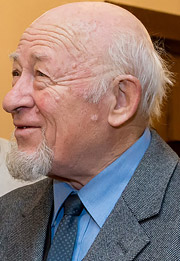
Electronic english version since 2022 |
The newspaper was founded in November 1957
| |
After the departed

| Siegfried Mattis 08.08.1937 - 02.25.2023 |
Frank Laboratory of Neutron Physics has suffered a great loss - a wonderful person, our friend and colleague theoretical physicist from Germany Siegfried Mattis passed away. His life and work were intimately related with the Joint Institute for Nuclear Research.
Siegfried Mattis was born on 8 August, 1937 near Dresden in the family of a tinsmith. In 1955, he was sent to study at the Physics Department of Leningrad State University. In 1963, he defended his PhD thesis on nucleon associations in light nuclei at SINP MSU. After returning to Germany in 1964, Siegfried became a staff member of the Central Institute of Nuclear Research in Rossendorf where he worked for seven years with the famous theoretical physicist Klaus Fuchs. Together with Soviet research carried out in Melekess (now, Dimitrovgrad), within the framework of the programme for the development of a fast neutron nuclear reactor, he investigated the behavior and possibility of processing paste-like nuclear fuel based on liquid sodium, using the apparatus of statistical physics and rheology.
The first creative period of S.Mattis' life in FLNP dates back 1971-1977. At that time, at the suggestion of F.L.Shapiro and headed by K.Hennig, a German group was established to study the energy levels of 4f-electrons in an electric crystal field. An experienced theoretician was needed to interpret experiments on inelastic neutron scattering. Based on the results of this work, in 1978, S. Mattis defended his PhD thesis at the Technical University of Dresden.
This was followed by a new steep turn in his life. From 1977 to 1991, he worked at the Department of Neutron Diffraction of the Central Institute of Nuclear Research in Rossendorf where he developed a theoretical apparatus for the quantitative texture analysis of polycrystalline matter and its application in materials science. Those investigations brought him worldwide fame. From 1980 to 2010, S.Mattis was on many occasions invited as a professor at various universities in the USA (Berkeley), France (Metz, Le Mans), South Korea (Seoul), Italy (Trento) and others where he lectured and improved his proposed techniques.
Having been officially retired, S. Mattis accepted the invitation of FLNP Directorate and from 2007 to 2012 worked for several months a year as a leading researcher in the group of Professor A.N.Nikitin. During this time, he developed a new technique to describe the elastic properties of multiphase highly anisotropic polycrystalline materials containing pores, cracks and grains of various shapes and orientations, as well as software for their calculation.
Professor S.Mattis was a member of the German Physical Society, the German Society for Materials Science, a professor of Theoretical Physics at the Academy of Sciences of the GDR and was awarded the Gustav Hertz Prize of the German Physical Society. About 130 scientific articles and monographs of him were published.
Our colleague was dedicated to his work and able to share his knowledge with young physicists. He will always be remembered as an intelligent, decent and always open-minded person, a true scientist and friend.
Students and colleagues